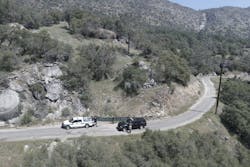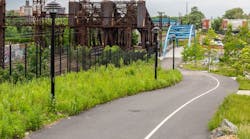As wildfires and dangerous post-disaster events continue to wreak havoc in affected areas in western states, many municipalities are taking significant steps to mitigate erosion risks and dangerous conditions once these fires are extinguished.
One of the most significant problems following these rampant fires involves the destruction of root systems that are instrumental in holding land in place on local hillsides and embankments. Once the vegetation and root systems are destroyed, there is little to protect against hillside erosion and mudslides, which can destroy homes, impact roadway ingress or egress and cause damage to infrastructure.
A Real-life Look
This was the case in Madera County, California, when in 2020, the largest single fire in state history destroyed almost 400,000 acres in the Sierra National Forest. During the fire, the Madera County Sheriff & Office of Emergency Services began making plans for how to address potentially catastrophic post-fire erosion and mudslides, which would cause long-lasting problems including the destruction of property and roads. The key concern was that hillside erosion and mudslides would severely limit the ability of first responders to deploy rescue and ambulance crews to the most affected areas in Madera County.
In the weeks leading up to and following the fires, a plan was put in place that involved the county government, engineering professionals, and a private company that had developed a unique and rapidly installed soil stabilization system. The goal was to keep the county’s roads accessible and functional by preventing closure due to erosion caused by the post-fire soil destabilization on adjacent hillsides.
This project brought awareness to other municipalities and homeowners, offering a solution to the existing conditions while showing they could take aggressive steps to mitigate damages to property following these fires, which are growing in intensity and frequency.
This dynamic public/private initiative involved an intricate communication plan among these parties:
- A willingness of the Madera County Sheriff & Office of Emergency Services to identify the risks and reach out to the private sector for affordable solutions that would be partially funded by FEMA;
- Hiring California-based engineering firm ENGEO to study the risk areas and identify specific areas of the major roads that could be blocked by post-fire erosion and mudslide materials; and
- Combining efforts with SOX Erosion Solutions, the developer of SOXFence, pre- and post-event soil containment and risk mitigation systems.
The Next Steps
Once these relationships were in place, the three organizations went to work on their specific areas of expertise which involved securing manpower for the installation, identifying vulnerable “hot spots” along the major roadways, and developing a plan for educating installers on best practices for deploying the SOXfence system. SOXfence is a patented fire retardant and flood resistance perimeter barrier that is quickly installed, lightweight and reusable. It has been effective in preventing post-fire erosion caused by damaged root systems.
With limited funding, the Madera County Sheriff & Office of Emergency Services turned to retired police officers to do the installation of the SOXfence system. Following a fire, it has been effective in preventing post-fire erosion caused by destroyed root systems and subsequent flooding and mudslides that block roads and damage buildings and homes.
ENGEO was charged with identifying vulnerable areas on the roadway and then recommended the use of the system for a variety of reasons including:
- Affordability;
- Rapid installation;
- Lightweight with high performance; and
- Versatility because it can be removed and reused in other areas.
ENGEO determined that a total of 4,000 feet of SOXfence would be installed along the 5 to 10 mile road section at risk. Approximately 40 sections of no more than 100 feet were placed adjacent to ravines and other areas that would channel mud and debris onto the road.
The SOX staff developed a two-day orientation program for the retired police officers on the most effective installation techniques, such as:
- Site preparation;
- Testing the substrate to determine the best posts to use; and
- Determining which anchoring systems to use, such as metal T-posts or untreated wooden stakes.
The staff was on site to supervise the actual installation. The entire 4,000 feet of the fence system was installed in two days. The teamwork displayed in this public/private partnership has become a model for subsequent projects to address issues related to the pre- and post-fire challenges. Most important is that this project protected county roads that provided access and egress to affected areas.
According to the Madera County Sheriff Office, it is likely these efforts saved the roads and lives.
Another major benefit of this project is that it brought awareness to residents and other cities on how they can protect their properties with the installation of SOXfence and other measures recommended by government agencies. They also became more focused on other ways to reduce post-fire erosion.
For example, the California Department of Forestry (CDF) recommends the removal of highly combustible shrubs, trees and loose debris. The CDF also urges homeowners to use stone walls and gravel as fire breaks. Home decks, flammable furniture, wood piles and overhangs should also be at least 5 feet from the home.
Other steps recommended by FEMA include:
- Removing branches that hang over the roof;
- Placing firewood and compost piles at least 30 feet from structures;
- Cleaning pine needles, dead plants, etc. from gutters and surrounding areas;
- Using stone or gravel mulch;
- Thinning trees as a way to disrupt a “fire ladder;"
- Creating defensible space with fire breaks such as driveways, walkways, patios, fences, streams, etc; and
- Replacing combustible fencing or gates at least within 5 feet of the home.
A wider landscape stabilization program also includes:
- Control of invasive pioneer plant and insect species;
- Planting of perennials suited for recovery; and
- Large-scale seeding.
Critical Steps
These activities and others are critically important in mitigating damage, saving lives and restoring order. They also offer a variety of social, technical, economic and ecological benefits, according to FEMA.
The government agency cites that these efforts “provide better accessibility for emergency personnel and first responders, reduce landscaping maintenance and insurance costs, promote diverse eco-systems and preserve healthy wildlife habitats, and enhance community safety and resilience.”
The work done by the Madera County Sheriff and Office of Emergency Services, ENGEO and SOX Erosion Solutions brought awareness to the problems and solutions associated with rampant wildfires, which will continue to ravage California and other western states. While not a new phenomenon, these wildfires are increasing in intensity and frequency.
The spirit of cooperation and communication was key in developing a long-lasting plan to mitigate damage while creating an effective soil stabilization plan that can save property and infrastructure.
About the author:
Ryan G. Leeds is CEO and managing partner of SOX Erosion Solutions. Leeds can be reached at [email protected].






